英语不规则变化名词十一大类归纳总结
- 格式:doc
- 大小:17.50 KB
- 文档页数:4
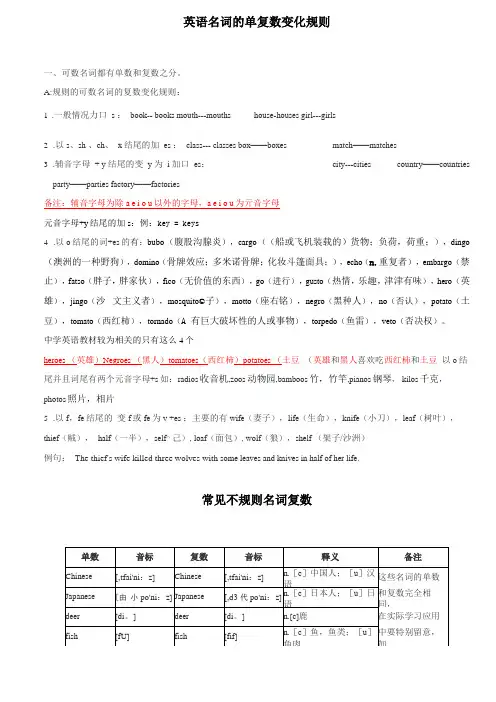
英语名词的单复数变化规则一、可数名词都有单数和复数之分。
A:规则的可数名词的复数变化规则:1.一般情况力口s :book-- books mouth---mouths house-houses girl---girls2.以s、sh 、ch、x结尾的加es :class--- classes box——boxes match——matches3.辅音字母+ y 结尾的变y 为i 加口es:city---cities country——countriesparty——parties factory——factories备注:辅音字母为除a e i o u以外的字母,a e i o u为亓音字母元音字母+y结尾的加s:例:key = keys4.以o结尾的词+es的有:bubo (腹股沟腺炎),cargo ((船或飞机装载的)货物;负荷,荷重;),dingo (澳洲的一种野狗),domino(骨牌效应;多米诺骨牌;化妆斗篷面具;),echo(n.重复者),embargo(禁止),fatso(胖子,胖家伙),fico(无价值的东西),go(进行),gusto(热情,乐趣,津津有味),hero(英雄),jingo(沙文主义者),mosquito©子),motto(座右铭),negro(黑种人),no(否认),potato(土豆),tomato(西红柿),tornado(A 有巨大破坏性的人或事物),torpedo(鱼雷),veto(否决权)。
中学英语教材较为相关的只有这么4个heroes (英雄)Negroes (黑人)tomatoes(西红柿)potatoes (土豆(英雄和黑人喜欢吃西红柿和土豆以o结尾并且词尾有两个元音字母+s如:radios收音机,zoos动物园,bamboos竹,竹竿,pianos钢琴, kilos千克,photos照片,相片5.以f,fe结尾的变f或fe为v +es :主要的有wife(妻子),life(生命),knife(小刀),leaf(树叶),thief(贼),half(一半),self^ 己),loaf(面包),wolf(狼),shelf (架子/沙洲)例句:The thief's wife killed three wolves with some leaves and knives in half of her life.常见不规则名词复数1.英语中有些名词单复数同行,主要有以下几类:A)、某些动物名词B)、某些表示人的名词C)、craft及由-craft构成的名词D)、某些表示数量的名词E)、其他2.以下这些名词单复数同形:antelope 羚羊,bison 野牛,buffalo 水牛,crab 螃蟹,deer 鹿,fish 鱼,reindeer 驯鹿,sheep 绵羊;Burmese缅甸人,Cantonese广东人,Chinese中国人,counsel法律顾问,kin亲属,Japanese日本人,Swiss 瑞士人;aircraft 飞机,craft 飞机,spacecraft 太空船;brance 双,score 二十;series 系列;species 种类;means方法只有复数形式的名词trousers裤子,pants裤子,shorts短裤glasses眼镜,compasses 圆规,scales天平,pliers钳子,clips剪子。
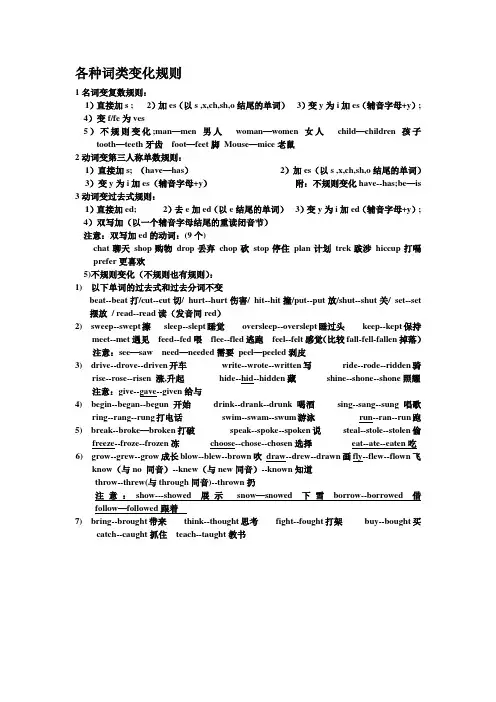
各种词类变化规则1名词变复数规则:1)直接加s ; 2)加es(以s ,x,ch,sh,o结尾的单词)3)变y为i加es(辅音字母+y); 4)变f/fe为ves5)不规则变化;man—men男人woman—women女人child—children孩子tooth—teeth牙齿foot—feet脚Mouse—mice老鼠2动词变第三人称单数规则:1)直接加s; (have—has)2)加es(以s ,x,ch,sh,o结尾的单词)3)变y为i加es(辅音字母+y)附:不规则变化have--has;be—is 3动词变过去式规则:1)直接加ed; 2)去e加ed(以e结尾的单词)3)变y为i加ed(辅音字母+y); 4)双写加(以一个辅音字母结尾的重读闭音节)注意:双写加ed的动词:(9个)chat聊天shop购物drop丢弃chop砍stop停住plan计划trek跋涉hiccup打嗝prefer更喜欢5)不规则变化(不规则也有规则):1) 以下单词的过去式和过去分词不变beat--beat打/cut--cut切/ hurt--hurt伤害/ hit--hit撞/put--put放/shut--shut关/ set--set 摆放/ read--read读(发音同red)2) sweep--swept擦sleep--slept睡觉oversleep--overslept睡过头keep--kept保持meet--met遇见feed--fed喂flee--fled逃跑feel--felt感觉(比较fall-fell-fallen掉落)注意:see—saw need—needed需要peel—peeled剥皮3) drive--drove--driven开车write--wrote--written写ride--rode--ridden骑rise--rose--risen 涨,升起hide--hid--hidden藏shine--shone--shone照耀注意:give--gave--given给与4) begin--began--begun开始drink--drank--drunk喝酒sing--sang--sung 唱歌ring--rang--rung打电话swim--swam--swum游泳run--ran--run跑5) break--broke—broken打破speak--spoke--spoken说steal--stole--stolen偷freeze--froze--frozen冻choose--chose--chosen选择eat--ate--eaten吃6) grow--grew--grow成长blow--blew--brown吹draw--drew--drawn画fly--flew--flown飞know(与no 同音)--knew(与new同音)--known知道throw--threw(与through同音)--thrown扔注意:show---showed展示snow—snowed 下雪borrow--borrowed借follow—followed跟着7) bring--brought带来think--thought思考fight--fought打架buy--bought买catch--caught抓住teach--taught教书8) say--said--said说pay--paid--paid付钱lay--laid--laid躺下lie—lied, lay---lied, lain撒谎,下蛋(注意和lay 区别)注意:play--played玩stay--stayed呆may--might可以9) take--took--taken拿走mistake--mistook--mistaken误解shake--shook--shaken摇晃wake--woke--woken醒来10) lend--lent借出send--sent发送spend--spent度过注意:end--ended 结束pretend—pretended假装11) get--got—got, gotten得到forget--forgot--forgot, forgotten忘记12) stand--stood---stood 站,忍受understand--understood--understood理解13) spell--spelt--spelt拼写smell—smelt闻sell--sold--sold卖tell--told--told告诉14) dream--dreamt做梦learn--learnt学会mean --meant意思15) see—saw--seen看见be--was/were--been是16) come--came--come来become--became--become变成17) sit--sat--sat坐babysit--babysat--babysat临时照顾18) shall/can/will--should/could/would19) go/goes--went--gone去do/does--did--done做,助动词20) wear--wore--worn穿bear--bore--born出生21) hold--held--held握住,举办find--found--found发现,找到lead--led--led引导have/has--had--had有hear--heard--heard听见make--made--made制造shoot--shot--shot射击lose--lost--lost丢失leave--left--left离开,留下build--built--built建造hang--hanged(hung)绞死,挂(hang out闲逛) win--won—won(与one同音)赢4形容词变比较级、最高级规则:1)直接加er/est; 2)去e加er/est(以e结尾的单词)3)变y为i加ed(辅音字母+y); 4)双写加(以一个辅音字母结尾的重读闭音节)注意:双写加er/est的单词有:(6个)red big hot wet thin fat5)不规则变化好good/well--更好better--最好--best 坏bad/badly--更坏worse--最坏worst 许多many/much--更多more--最多most 一点little--较少less--最少least 远far--较远farther/further (意义深远)--最远farthest/furthest老的,旧的old--较老的,较旧的older/elder(大哥)--最老的最旧的oldest/eldest 5动词变现在分词规则:1)直接加ing; 2)去e加ing(以e结尾的单词),但lie-lying躺die-dying死亡tie-tying系see-seeing看见be-being是3)双写加(以一个辅音字母结尾的重读闭音节)注意:双写加ing的动词:(25个)get得到set安排let让sit坐hit撞fit适合win赢kid开玩笑run跑cut 切put放hum哼唱chat聊天plan计划shop购物drop扔chop砍stop 停shut关swim游泳trek跋涉star主演begin开始forget忘记prefer更喜欢hiccup打嗝baby-sit临时照顾6基数词变序数词规则:1)直接加th; 4)变ve为f加th(如five—fifth twelve—teelfth)2)去e加th(nine--ninth)3)变y为i加eth(辅音字母+y,整十单词都带ty); 5)不规则变化:first second third7形容词变副词规则:1)直接加ly 2)变y为i加ly(辅音字母+y)3)不去e加ly 5)不规则变化:possible--possibly可能的terrible--terribly糟糕的simple--simply简单的true--truly真的8代词变反身代词:1)单数加self,复数加selves(变f为v加es),2)第一二人称在形容词物主代词的基础上加self\selves,第三人称在人称代词的宾格的基础上加self\selves注意:1 任何双写单词都有一个共同规律:最后两个字母必须是一个元音字母加一个辅音字母,而且不可以合起来发音,如few, show就不可双写。

英语单词变化规则大汇总(总11页) -本页仅作为预览文档封面,使用时请删除本页-英语单词的各种变化规则一、名词复数变化:(二)名词复数的不规则变化:1.child→children(儿童)man→men(男人)woman→women (女人)an Englishman→two Englishmen(英国人)foot→feet(脚)tooth→teeth (牙)mouse→mice(老鼠)ox →oxen(公牛)goose→geese(鹅)2.单复同形deer,sheep,fish,Chinese,Japanese,Swiss, species,means除人民币,美元、英镑、法郎等都有复数形式。
如:a dollar,two dollars; a meter,two meters3.集体名词,以单数形式出现,但实为复数。
people police cattle是复数(Correctness:a person,a policeman,a head of cattle,the English,the British,the French,the Chinese,the Japanese,the Swiss )(Error:a people,a police,a cattle )表示国民总称时,作复数用。
(The Chinese are industrious and brave. 中国人民是勤劳勇敢的。
)4.以s结尾,仍为单数的名词1)maths,politics,physics等学科名词,为不可数名词,是单数。
2)news是不可数名词。
5. 表示由两部分构成的东西,glasses(眼镜) trousers (长裤) clothes(衣服)若表达具体数目,要借助数量词pair(对,双)a pair of glasses ,two pairs of trousers\suit(套)6.另外还有一些名词,其复数形式有时可表示特别意思goods (货物) waters (水域) fishes (各种鱼)练习:写出下列各词的复数I _________ him _________ this ___________ her ______watch _______ child _______ photo ________ diary ______day________ foot________ book_______ dress ________tooth_______ sheep ______ box________ strawberry _____thief _______ fish______ peach______ sandwich ______man______ woman_______ paper_______ juice___________water________ milk________ rice__________ tea__________二、序数词变化规则(一)一般化规则:基数词+th→序数词(规则变化)four(四)→fourth(第四)six(六)→sixth(第六)seven(七)→seventh(第七)ten(十)→tenth(第十)eleven(十一)eleventh→(第十一)(二)**不规则变化的one(一)→first(第一) twenty-one → twenty-firsttwo(二)→second(第二)three(三)→third(第三)five(五)→fifth(第五)eight(八)→eighth(第八) fifty-eight → fifty-eighth nine(九)→ninth(第九)twelve(十二)→twelfth(第十二)(三)从13—19的基数词,都在个位数后加teen构成14→fourteen15→fifteen16→sixteen17→seventeen18→eighteen19→nineteen(四)整十的序数词,变y为ie再加th20 twenty→twentieth第二十30 thirty→thirtieth第三十40 forty→fortieth第十四50 fifty→fiftieth第五十60 sixty→sixtieth第六十70 seventy→seventieth第七十80 eight→eightieth第八十90 ninety→ninetieth第九十(五)分数的表达:分子用:基数词分母用:序数词特别要注意:当分子大于1时,分母要用:复数1/2 one second ; a half ; 1/4 a quarter ;3/4 three quarters 7/8 seven eighths3/5 three fifths(六)加减乘除表达a decimal number 小数a fraction 分数a percentage 百分数a odd number奇数an even number 偶数degrees 度数1) 加:and; plus; add to2+4=6Two and four is/equals six.或Two plus four is/equals six.或Two added to four equals six.2)减:minus ; subtract from 8-3=5Eight minus three is/equals five.或Three subtracted from eight is five.3)乘:multiply...by;multiplied by /times 3×5=15Multiply three by five is/equals fifteen.或Three multiplied by five is/equals fifteen.4)除:divide by.../divide ...by... 24÷8=3Twenty-four divided by eight is/equals three.或Divide 24 by 8 is /equals three.三.形容词比较级和最高级的变化规则:1.一般在词尾加er/est;2.以字母e 结尾,加r/st ;3.以一个元音字母和一个辅音字母结尾,应双写末尾的辅音字母,再加er/st ;原级比较级最高级slim slimmer slimmestbig bigger biggesthot hotter hottestfat fatter fattestthin thinner thinnestwet wetter wettestred redder reddestsad sadder saddest4.以“辅音字母+y”结尾,先把y变i,再加er/st5.多音节词.和部分双音节词,在单词前面加more或mostimportant more important most importantdifficult more difficult most difficultinteresting more interesting most interestinguseful more useful most usefulbeautiful more beautiful most beautiful6.不规则形容词比较级:原级比较级最高级good/well better bestbad/ill worse worstmany/much more mostlittle less leastold older/elder oldest/eldestred redder reddestfar further/farther furthest /farthest写出下列形容词的比较级和最高级old__________ young________ tall_______ long________short________ strong________ big________ small_______fat_________ thin__________ heavy______ light________nice________ good_________ beautiful____________________high_________ slow_______ fast________ low______late__________ early_________ far_________ well_______四.动词第三人称单数变化规则1.一般情况下,直接加-s,如:cook-cooks, milk-milks2.以s. x. sh. ch. o结尾,加-es,如:guess-guesses, wash-washes, watch-watches, go-goes3.以“辅音字母+y”结尾,变y为i, 再加-es,如:study-studies写出下列动词的第三人称单数drink ________ go _________ stay ________ make ________look _________ have_______ pass_______ carry ________come________ watch______ plant_______ fly __________study_______ brush________ do_________ teach________五.动词现在分词加ing的变化规则1.一般情况下,直接加ing,如:cook-cooking2.以不发音的e结尾,去e加ing,如:make-making, taste-tasting3. 以ie结尾的动词,把ie变为y再加ing。
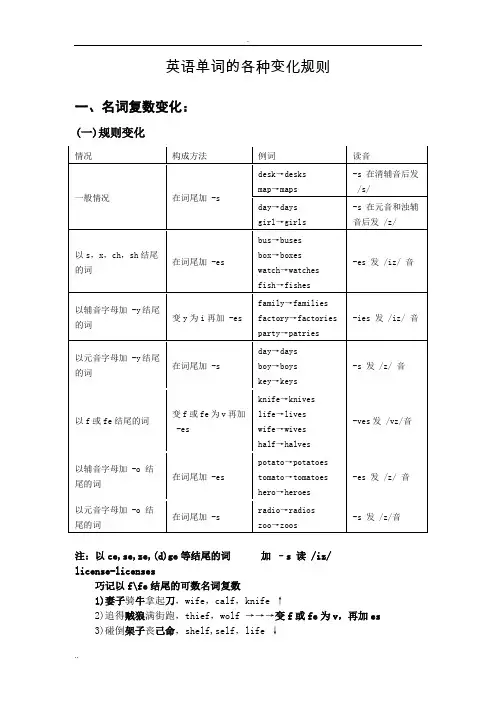
英语单词的各种变化规则一、名词复数变化:(二)名词复数的不规则变化:1.child→children(儿童)man→men(男人)woman→women (女人)an Englishman→two Englishmen(英国人)foot→feet(脚)tooth→teeth(牙)mouse→mice(老鼠)ox →oxen(公牛)goose→geese(鹅)2.单复同形deer,sheep,fish,Chinese,Japanese,Swiss, species,means除人民币,美元、英镑、法郎等都有复数形式。
如:a dollar,two dollars; a meter,two meters3.集体名词,以单数形式出现,但实为复数。
people police cattle是复数(Correctness:a person,a policeman,a head of cattle,the English,the British,the French,the Chinese,the Japanese,the Swiss )(Error:a people,a police,a cattle )表示国民总称时,作复数用。
(The Chinese are industrious and brave. 中国人民是勤劳勇敢的。
)4.以s结尾,仍为单数的名词1)maths,politics,physics等学科名词,为不可数名词,是单数。
2)news是不可数名词。
5. 表示由两部分构成的东西,glasses(眼镜) trousers (长裤) clothes(衣服)若表达具体数目,要借助数量词pair(对,双)a pair of glasses ,two pairs of trousers\suit(套)6.另外还有一些名词,其复数形式有时可表示特别意思goods (货物) waters (水域) fishes (各种鱼)练习:写出下列各词的复数I _________ him _________ this ___________ her ______watch _______ child _______ photo ________ diary ______day________ foot________ book_______ dress ________tooth_______ sheep ______ box________ strawberry _____ thief _______ fish______ peach______ sandwich ______man______ woman_______ paper_______ juice___________ water________ milk________ rice__________ tea__________二、序数词变化规则(一)一般化规则:基数词+th→序数词(规则变化)four(四)→fourth(第四)six(六)→sixth(第六)seven(七)→seventh(第七)ten(十)→tenth(第十)eleven(十一)eleventh→(第十一)(二)**不规则变化的one(一)→first(第一)twenty-one →twenty-firsttwo(二)→second(第二)three(三)→third(第三)five(五)→fifth(第五)eight(八)→eighth(第八)fifty-eight →fifty-eighthnine(九)→ninth(第九)twelve(十二)→twelfth(第十二)(三)从13—19的基数词,都在个位数后加teen构成14→fourteen15→fifteen16→sixteen17→seventeen18→eighteen19→nineteen(四)整十的序数词,变y为ie再加th20 twenty→twentieth第二十30 thirty→thirtieth第三十40 forty→fortieth第十四50 fifty→fiftieth第五十60 sixty→sixtieth第六十70 seventy→seventieth第七十80 eight→eightieth第八十90 ninety→ninetieth第九十(五)分数的表达:分子用:基数词分母用:序数词特别要注意:当分子大于1时,分母要用:复数1/2 one second ; a half ; 1/4 a quarter ;3/4 three quarters 7/8 seven eighths3/5 three fifths(六)加减乘除表达a decimal number 小数a fraction 分数a percentage 百分数a odd number奇数an even number 偶数degrees 度数1) 加:and; plus; add to2+4=6Two and four is/equals six.或Two plus four is/equals six.或Two added to four equals six.2)减:minus ; subtract from 8-3=5Eight minus three is/equals five.或Three subtracted from eight is five.3)乘:multiply...by;multiplied by /times 3×5=15Multiply three by five is/equals fifteen.或Three multiplied by five is/equals fifteen.4)除:divide by.../divide ...by... 24÷8=3Twenty-four divided by eight is/equals three.或Divide 24 by 8 is /equals three.三.形容词比较级和最高级的变化规则:1.一般在词尾加er/est;2.以字母e 结尾,加r/st ;3.以一个元音字母和一个辅音字母结尾,应双写末尾的辅音字母,再加er/st ;原级比较级最高级slim slimmer slimmestbig bigger biggesthot hotter hottestfat fatter fattestthin thinner thinnestwet wetter wettestred redder reddestsad sadder saddest4.以“辅音字母+y”结尾,先把y变i,再加er/st5.多音节词.和部分双音节词,在单词前面加more或mostimportant more important most importantdifficult more difficult most difficultinteresting more interesting most interestinguseful more useful most usefulbeautiful more beautiful most beautiful6.不规则形容词比较级:原级比较级最高级good/well better bestbad/ill worse worstmany/much more mostlittle less leastold older/elder oldest/eldestred redder reddestfar further/farther furthest /farthest写出下列形容词的比较级和最高级old__________ young________ tall_______ long________ short________ strong________ big________ small_______ fat_________ thin__________ heavy______ light________ nice________ good_________ beautiful____________________ high_________ slow_______ fast________ low______ late__________ early_________ far_________ well_______ 四.动词第三人称单数变化规则1.一般情况下,直接加-s,如:cook-cooks, milk-milks2.以s. x. sh. ch. o结尾,加-es,如:guess-guesses, wash-washes, watch-watches, go-goes3.以“辅音字母+y”结尾,变y为i, 再加-es,如:study-studies写出下列动词的第三人称单数drink ________ go _________ stay ________ make ________ look _________ have_______ pass_______ carry ________ come________ watch______ plant_______ fly __________ study_______ brush________ do_________ teach________ 五.动词现在分词加ing的变化规则1.一般情况下,直接加ing,如:cook-cooking2.以不发音的e结尾,去e加ing,如:make-making, taste-tasting3. 以ie结尾的动词,把ie变为y再加ing。
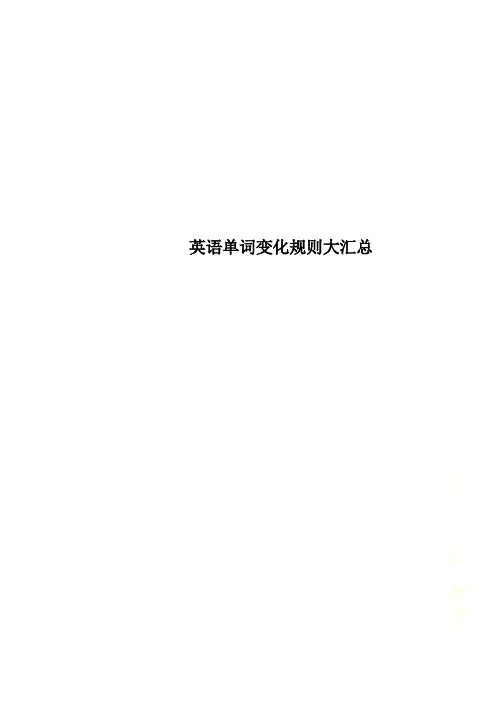
英语单词变化规则大汇总英语单词的各种变化规则一、名词复数变化:(一)规则变化情况构成方法例词读音一般情况在词尾加-sdesk→desksmap→maps-s 在清辅音后发/s/day→daysgirl→girls-s 在元音和浊辅音后发 /z/以s,x,ch,sh结尾的词在词尾加-esbus→busesbox→boxeswatch→watchesfish→fishes-es 发 /iz/ 音以辅音字母加 -y结尾的词变y为i再加 -esfamily→familiesfactory→-ies 发/iz/ 音factories party→pa tries以元音字母加 -y结尾的词在词尾加-sday→daysboy→boyskey→keys-s 发 /z/ 音以f或fe结尾的词变f或fe为v再加-esknife→kniveslife→liveswife→wiveshalf→halves-ves发/vz/音以辅音字母加 -o 结尾的词在词尾加-espotato→potatoestomato→tomatoeshero→heroes-es 发 /z/ 音以元音字母加 -o 结尾在词尾加-sradio→radios-s 发 /z/音的词zoo→zoos注:以ce,se,ze,(d)ge等结尾的词加–s 读 /iz/license-licenses巧记以f\fe结尾的可数名词复数1)妻子骑牛拿起刀,wife,calf,knife ↑2)追得贼狼满街跑,thief,wolf →→→变f或fe为v,再加es3)碰倒架子丧己命,shelf,self,lif e ↓4)手帕树叶半空飘。
handkerchief,leaf,half ↓(二)名词复数的不规则变化:1.child→children(儿童)man→men(男人)woman→women (女人)an Englishman→two Englishmen(英国人)foot→feet(脚)tooth→teeth(牙)mouse→mice(老鼠)ox →oxen(公牛)goose→geese(鹅)2.单复同形deer,sheep,fish,Chinese,Japanese,Swiss, species,means除人民币,美元、英镑、法郎等都有复数形式。
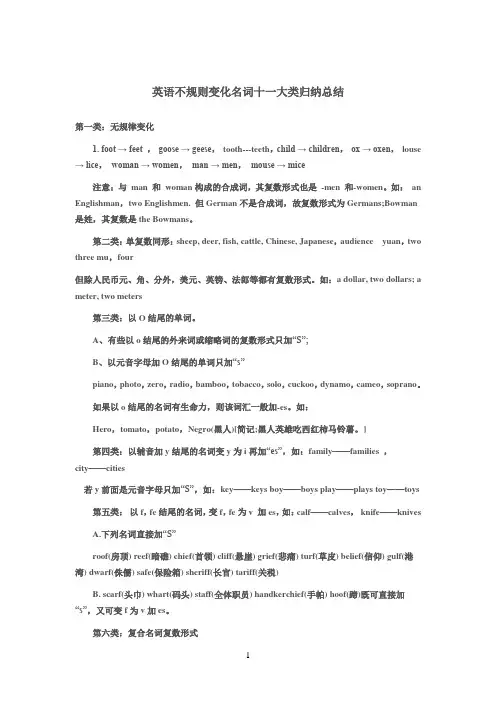
英语不规则变化名词十一大类归纳总结第一类:无规律变化1. foot → feet ,goose → geese,tooth---teeth,child → children,ox → oxen,louse → lice,woman → women,man → men,mouse → mice注意:与man 和woman构成的合成词,其复数形式也是-men 和-women。
如:an Englishman,two Englishmen. 但German不是合成词,故复数形式为Germans;Bowman 是姓,其复数是the Bowmans。
第二类:单复数同形:sheep, deer, fish, cattle, Chinese, Japanese,audience yuan,two three mu,four但除人民币元、角、分外,美元、英镑、法郎等都有复数形式。
如:a dollar, two dollars; a meter, two meters第三类:以O结尾的单词。
A、有些以o结尾的外来词或缩略词的复数形式只加“S”;B、以元音字母加O结尾的单词只加“s”piano,photo,zero,radio,bamboo,tobacco,solo,cuckoo,dynamo,cameo,soprano。
如果以o结尾的名词有生命力,则该词汇一般加-es。
如:Hero,tomato,potato,Negro(黑人)[简记;黑人英雄吃西红柿马铃薯。
]第四类:以辅音加y结尾的名词变y为i再加“es”,如:family——families ,city——cities若y前面是元音字母只加“S”,如:key——keys boy——boys play——plays toy——toys 第五类:以f,fe结尾的名词,变f,fe为v 加es,如:calf——calves,knife——knivesA.下列名词直接加“S”roof(房顶) reef(暗礁) chief(首领) cliff(悬崖) grief(悲痛) turf(草皮) belief(信仰) gulf(港湾) dwarf(侏儒) safe(保险箱) sheriff(长官) tariff(关税)B. scarf(头巾) whart(码头) staff(全体职员) handkerchief(手帕) hoof(蹄)既可直接加“s”,又可变f为v加es。
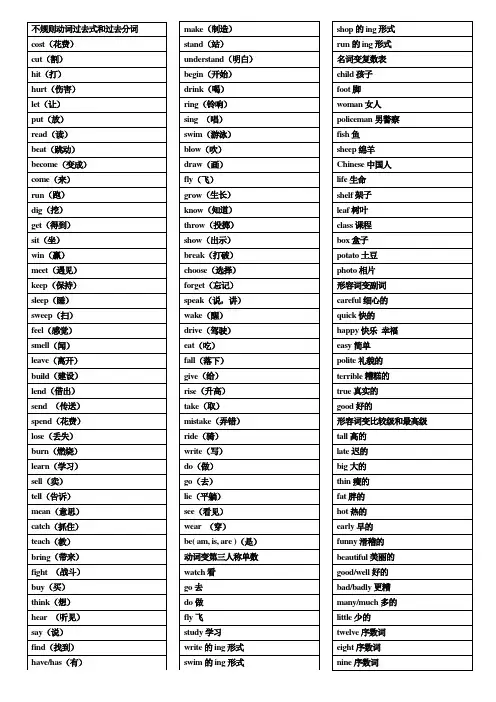
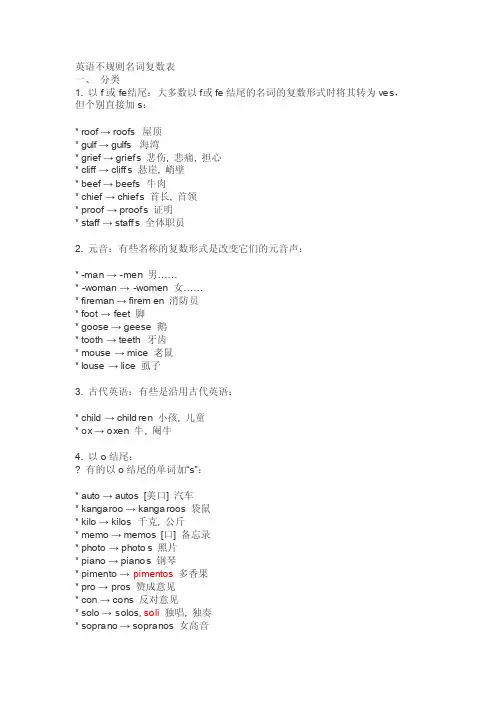
英语不规则名词复数表一、分类1. 以f或fe结尾:大多数以f或fe结尾的名词的复数形式时将其转为ves,但个别直接加s:* roof→roofs屋顶* gulf→gulfs海湾* grief→griefs悲伤, 悲痛, 担心* cliff→cliffs悬崖, 峭壁* beef→beefs牛肉* chief→chiefs首长, 首领* proof→proofs证明* staff→staffs全体职员2. 元音:有些名称的复数形式是改变它们的元音声:* -man→-men 男……* -woman→-women女……* firema n→fireme n 消防员*foot→feet脚* goose→geese鹅* tooth→teeth牙齿* mouse→mice老鼠* louse→lice虱子3. 古代英语:有些是沿用古代英语:* child→childr en 小孩, 儿童*ox→o xen 牛, 阉牛4. 以o结尾:有的以o结尾的单词加“s”:* auto→autos[美口] 汽车* kangar oo→kangar oos 袋鼠* kilo→kilos千克, 公斤* memo→memos[口] 备忘录* photo→photos照片* piano→pianos钢琴* piment o→piment os多香果*pro→pros赞成意见*con→cons反对意见*solo→s olos,soli独唱, 独奏* sopran o→sopran os 女高音* studio→studio s 工作室* tattoo→tattoo s 文身* video→videos视频*zoo→zoos动物园* bamboo→bamboo s 竹子有的则加“es”:* echo→echoes回声, 反响* embarg o→embarg oes 禁运, 禁运令* hero→heroes英雄* potato→potato es 土豆* tomato→tomato es 番茄* torped o→torped oes 鱼雷, 水雷* veto→vetoes否决, 否决权* negro→negroe s 黑人有的两种都可以:* buffal o→buffal os / buffal oes / buffal o 水牛* cargo→cargos / cargoe s (船/飞机的)货物* halo→halos/ haloes光环* mosqui to→mosqui tos / mosqui toes蚊子* motto→mottos / mottoe s 箴言, 格言*no→nos/noes没有* tornad o→tornad os / tornad oes 龙卷风* volcan o→volcan os / volcan oes 火山* zero→zeros/ zeroes零* comman do→comman ds / comman does突击员5. 不变:有的则不变:*cod→cod鳕鱼*deer→deer鹿*fish→fish鱼, 鱼类* offspr ing→offspr ing 子孙, 后裔, 幼崽* perch→perch鲈鱼* sheep→sheep绵羊* trout→trou鲑鱼* bison→bison野牛* moose→moose驼鹿* aircra ft→aircra ft 飞机, 飞行器* barrac ks→barrac ks 兵营* crossr oads→crossr oads十字路口*dice→dice骰子* gallow s→gallow s 绞刑架* headqu arter s→headqu arter s 总部* means→means方法, 手段, 途径* series→series系列* specie s→specie s 物种6. 借用单词:英语中有些单词是借用其他语言的。
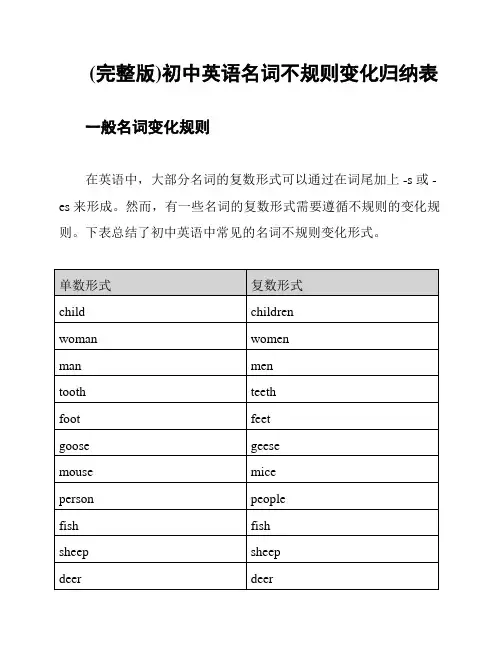
(完整版)初中英语名词不规则变化归纳表一般名词变化规则
在英语中,大部分名词的复数形式可以通过在词尾加上 -s 或 -es 来形成。
然而,有一些名词的复数形式需要遵循不规则的变化规则。
下表总结了初中英语中常见的名词不规则变化形式。
特殊复数形式
除了不规则的复数名词变化形式外,也有一些名词在复数形式
时保持不变,或者在复数形式中通过其他方式来表达复数含义。
下
表列出了一些常见的特殊复数形式。
注意:特殊复数形式中,这些名词的复数形式与单数形式相同,不加 -s 或 -es。
这个归纳表将帮助学生记忆初中英语中常见的名词不规则变化形式。
为了提高记忆效果,建议学生多加练,使用这些名词进行造句和对话。
请注意,此文档提供的信息仅供参考,具体的名词变化形式可能会因上下文和用法而有所不同。
建议学生在研究和使用这些名词时,多加注意和实践,以提高语言表达能力。
参考资料:。
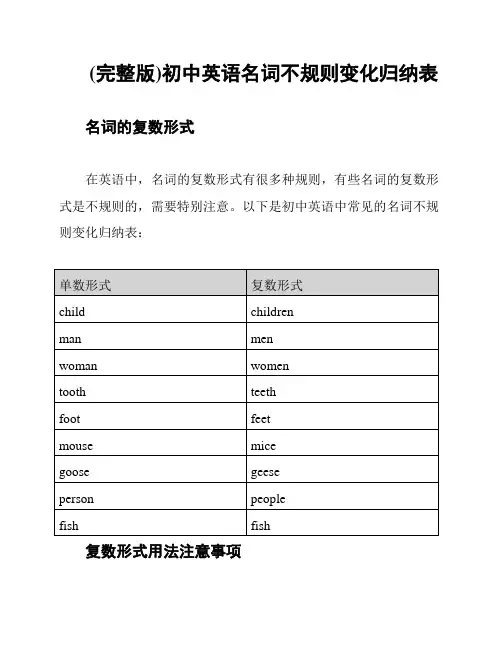
(完整版)初中英语名词不规则变化归纳表名词的复数形式在英语中,名词的复数形式有很多种规则,有些名词的复数形式是不规则的,需要特别注意。
以下是初中英语中常见的名词不规则变化归纳表:复数形式用法注意事项- 名词的不规则复数形式在单数和复数形式上有明显的变化,需要记住每个名词的具体形式。
- 复数形式的名词在句子中定语和主语的用法有所不同。
例如,当名词为单数时,定语和主语需要用单数形式;当名词为不规则复数形式时,定语和主语需要用复数形式。
例如:- 单数形式:This book is interesting. (定语)- 不规则复数形式:These books are interesting. (定语)- 单数形式:The child is crying. (主语)- 不规则复数形式:The children are playing. (主语)- 有些名词的复数形式和单数形式相同,如:deer、sheep、fish 等。
名词不规则变化练在研究名词的不规则变化时,我们需要进行大量的练来加深记忆。
以下是几个练题:1. 将下列名词的单数形式改为复数形式:(根据表格填入正确的单词)- tooth: ______________- fish: ______________- child: ______________2. 将下列名词的复数形式改为单数形式:(根据表格填入正确的单词)- geese: ______________- women: ______________- mice: ______________3. 填入正确的名词形式:(从括号中选择合适的名词形式填空)- This (man/men) is my father.- Those (mouse/mice) are running fast.- She has two (tooth/teeth).以上是初中英语名词不规则变化的归纳表和练习题,希望能够帮助大家更好地掌握名词复数形式的变化规则。
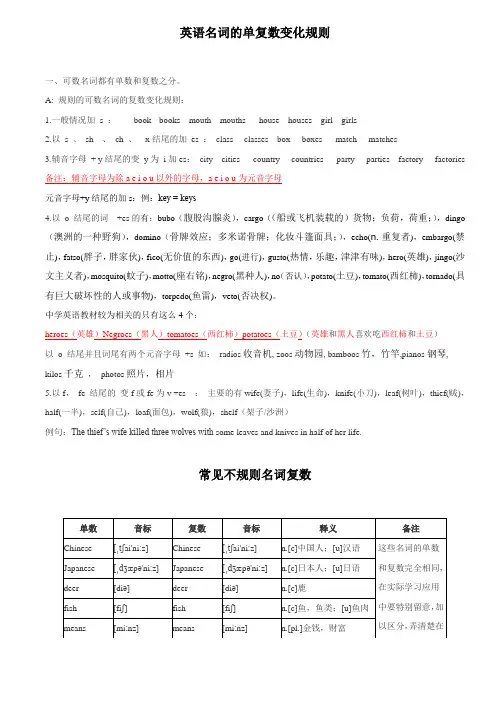
英语名词的单复数变化规则一、可数名词都有单数和复数之分。
A: 规则的可数名词的复数变化规则:1.一般情况加s :book-- books mouth---mouths house---houses girl---girls2.以s 、sh 、ch 、x结尾的加es :class--- classes box----boxes match----matches3.辅音字母+ y结尾的变y为i加es:city---cities country----countries party----parties factory----factories 备注:辅音字母为除a e i o u以外的字母,a e i o u为元音字母元音字母+y结尾的加s:例:key = keys4.以o 结尾的词+es的有:bubo(腹股沟腺炎),cargo((船或飞机装载的)货物;负荷,荷重;),dingo (澳洲的一种野狗),domino(骨牌效应;多米诺骨牌;化妆斗篷面具;),echo(n. 重复者),embargo(禁止),fatso(胖子,胖家伙),fico(无价值的东西),go(进行),gusto(热情,乐趣,津津有味),hero(英雄),jingo(沙文主义者),mosquito(蚊子),motto(座右铭),negro(黑种人),no(否认),potato(土豆),tomato(西红柿),tornado(具有巨大破坏性的人或事物),torpedo(鱼雷),veto(否决权)。
中学英语教材较为相关的只有这么4个:heroes(英雄)Negroes(黑人)tomatoes(西红柿)potatoes(土豆)(英雄和黑人喜欢吃西红柿和土豆)以o 结尾并且词尾有两个元音字母+s 如:radios收音机, zoos动物园, bamboos竹,竹竿,pianos钢琴, kilos千克,photos照片,相片5.以f,fe 结尾的变f或fe为v +es :主要的有wife(妻子),life(生命),knife(小刀),leaf(树叶),thief(贼),half(一半),self(自己),loaf(面包),wolf(狼),shelf(架子/沙洲)例句:The thief’s wife killed three wolves with some leaves and knives in half of her life.常见不规则名词复数1. 英语中有些名词单复数同行,主要有以下几类:A)、某些动物名词B)、某些表示人的名词C)、craft及由-craft构成的名词D)、某些表示数量的名词E)、其他2. 以下这些名词单复数同形:antelope 羚羊,bison 野牛,buffalo 水牛,crab 螃蟹,deer 鹿,fish 鱼,reindeer 驯鹿,sheep 绵羊;Burmese 缅甸人,Cantonese 广东人,Chinese 中国人,counsel 法律顾问,kin 亲属,Japanese 日本人,Swiss瑞士人;aircraft 飞机,craft 飞机,spacecraft 太空船;brance 双,score 二十;series 系列;species 种类;means方法只有复数形式的名词trousers裤子,pants裤子,shorts短裤glasses眼镜,compasses圆规,scales天平,pliers钳子,clips剪子。
英语不规则变化名词十一大类归纳总结第一类:无规律变化1. foot → feet ,goose → geese,tooth---teeth,child → children,ox → oxen,louse → lice,woman → women,man → men,mouse → mice注意:与man 和woman构成的合成词,其复数形式也是-men 和-women。
如:an Englishman,two Englishmen. 但German不是合成词,故复数形式为Germans;Bowman 是姓,其复数是the Bowmans。
第二类:单复数同形:sheep, deer, fish, cattle, Chinese, Japanese,audience yuan,two three mu,four但除人民币元、角、分外,美元、英镑、法郎等都有复数形式。
如:a dollar, two dollars; a meter, two meters第三类:以O结尾的单词。
A、有些以o结尾的外来词或缩略词的复数形式只加“S”;B、以元音字母加O结尾的单词只加“s”piano,photo,zero,radio,bamboo,tobacco,solo,cuckoo,dynamo,cameo,soprano。
如果以o结尾的名词有生命力,则该词汇一般加-es。
如:Hero,tomato,potato,Negro(黑人)[简记;黑人英雄吃西红柿马铃薯。
]第四类:以辅音加y结尾的名词变y为i再加“es”,如:family——families ,city——cities若y前面是元音字母只加“S”,如:key——keys boy——boys play——plays toy——toys 第五类:以f,fe结尾的名词,变f,fe为v 加es,如:calf——calves,knife——knivesA.下列名词直接加“S”roof(房顶) reef(暗礁) chief(首领) cliff(悬崖) grief(悲痛) turf(草皮) belief(信仰) gulf(港湾) dwarf(侏儒) safe(保险箱) sheriff(长官) tariff(关税)B. scarf(头巾) whart(码头) staff(全体职员) handkerchief(手帕) hoof(蹄)既可直接加“s”,又可变f为v加es。
英语名词的单复数变化规则一、可数名词都有单数和复数之分。
A: 规则的可数名词的复数变化规则:1.一般情况加s :book-- books mouth---mouths house---houses girl---girls2.以s 、sh 、ch 、x结尾的加es :class--- classes box----boxes match----matches3.辅音字母+ y结尾的变y为i加es:city---cities country----countries party----parties factory----factories 备注:辅音字母为除a e i o u以外的字母,a e i o u为元音字母元音字母+y结尾的加s:例:key = keys4.以o 结尾的词+es的有:bubo(腹股沟腺炎),cargo((船或飞机装载的)货物;负荷,荷重;),dingo (澳洲的一种野狗),domino(骨牌效应;多米诺骨牌;化妆斗篷面具;),echo(n. 重复者),embargo(禁止),fatso(胖子,胖家伙),fico(无价值的东西),go(进行),gusto(热情,乐趣,津津有味),hero(英雄),jingo(沙文主义者),mosquito(蚊子),motto(座右铭),negro(黑种人),no(否认),potato(土豆),tomato(西红柿),tornado(具有巨大破坏性的人或事物),torpedo(鱼雷),veto(否决权)。
中学英语教材较为相关的只有这么4个:heroes(英雄)Negroes(黑人)tomatoes(西红柿)potatoes(土豆)(英雄和黑人喜欢吃西红柿和土豆)以o 结尾并且词尾有两个元音字母+s 如:radios收音机, zoos动物园, bamboos竹,竹竿,pianos钢琴, kilos千克,photos照片,相片5.以f,fe 结尾的变f或fe为v +es :主要的有wife(妻子),life(生命),knife(小刀),leaf(树叶),thief(贼),half(一半),self(自己),loaf(面包),wolf(狼),shelf(架子/沙洲)例句:The thief’s wife killed three wolves with some leaves and knives in half of her life.常见不规则名词复数1. 英语中有些名词单复数同行,主要有以下几类:A)、某些动物名词B)、某些表示人的名词C)、craft及由-craft构成的名词D)、某些表示数量的名词E)、其他2. 以下这些名词单复数同形:antelope 羚羊,bison 野牛,buffalo 水牛,crab 螃蟹,deer 鹿,fish 鱼,reindeer 驯鹿,sheep 绵羊;Burmese 缅甸人,Cantonese 广东人,Chinese 中国人,counsel 法律顾问,kin 亲属,Japanese 日本人,Swiss瑞士人;aircraft 飞机,craft 飞机,spacecraft 太空船;brance 双,score 二十;series 系列;species 种类;means方法只有复数形式的名词trousers裤子,pants裤子,shorts短裤glasses眼镜,compasses圆规,scales天平,pliers钳子,clips剪子。
英语单词的各种变化规则一、名词复数变化:1.child→children(儿童)man→men(男人)woman→women (女人)an Englishman→two Englishmen(英国人)foot→feet(脚)tooth→teeth(牙)mouse→mice(老鼠)ox →oxen(公牛)goose→geese(鹅)2.单复同形deer,sheep,fish,Chinese,Japanese,Swiss, species,means除人民币,美元、英镑、法郎等都有复数形式。
如:a dollar,two dollars; a meter,two meters 3.集体名词,以单数形式出现,但实为复数。
people police cattle是复数(Correctness:a person,a policeman,a head of cattle,the English,the British,the French,the Chinese,the Japanese,the Swiss )(Error:a people,a police,a cattle )表示国民总称时,作复数用。
(The Chinese are industrious and brave. 中国人民是勤劳勇敢的。
)4.以s结尾,仍为单数的名词1)maths,politics,physics等学科名词,为不可数名词,是单数。
2)news是不可数名词。
5. 表示由两部分构成的东西,glasses(眼镜) trousers (长裤) clothes(衣服)若表达具体数目,要借助数量词pair(对,双)a pair of glasses ,two pairs of trousers\suit (套)6.另外还有一些名词,其复数形式有时可表示特别意思goods (货物) waters (水域) fishes (各种鱼)练习:写出下列各词的复数I _________ him _________ this ___________ her ______watch _______ child _______ photo ________ diary ______day________ foot________ book_______ dress ________tooth_______ sheep ______ box________ strawberry _____thief _______ fish______ peach______ sandwich ______man______ woman_______ paper_______ juice___________water________ milk________ rice__________ tea__________二、序数词变化规则(一)一般化规则:基数词+th→序数词(规则变化)four(四)→fourth(第四)six(六)→sixth(第六)seven(七)→seventh(第七)ten(十)→tenth(第十)eleven(十一)eleventh→(第十一)(二)**不规则变化的one(一)→first(第一)twenty-one →twenty-firsttwo(二)→second(第二)three(三)→third(第三)five(五)→fifth(第五)eight(八)→eighth(第八)fifty-eight →fifty-eighthnine(九)→ninth(第九)twelve(十二)→twelfth(第十二)(三)从13—19的基数词,都在个位数后加teen构成14→fourteen15→fifteen16→sixteen17→seventeen18→eighteen19→nineteen(四)整十的序数词,变y为ie再加th20 twenty→twentieth第二十30 thirty→thirtieth第三十40 forty→fortieth第十四50 fifty→fiftieth第五十60 sixty→sixtieth第六十70 seventy→seventieth第七十80 eight→eightieth第八十90 ninety→ninetieth第九十(五)分数的表达:分子用:基数词分母用:序数词特别要注意:当分子大于1时,分母要用:复数1/2 one second ; a half ; 1/4 a quarter ;3/4 three quarters 7/8 seven eighths3/5 three fifths(六)加减乘除表达a decimal number 小数a fraction 分数a percentage 百分数a odd number奇数an even number 偶数degrees 度数1) 加:and; plus; add to2+4=6Two and four is/equals six.或Two plus four is/equals six.或Two added to four equals six.2)减:minus ; subtract from 8-3=5Eight minus three is/equals five.或Three subtracted from eight is five.3)乘:multiply...by;multiplied by /times 3×5=15Multiply three by five is/equals fifteen.或Three multiplied by five is/equals fifteen.4)除:divide by.../divide ...by... 24÷8=3Twenty-four divided by eight is/equals three.或Divide 24 by 8 is /equals three.三.形容词比较级和最高级的变化规则:1.一般在词尾加er/est;2.以字母e 结尾,加r/st ;3.以一个元音字母和一个辅音字母结尾,应双写末尾的辅音字母,再加er/st ;原级比较级最高级slim slimmer slimmestbig bigger biggesthot hotter hottestfat fatter fattestthin thinner thinnestwet wetter wettestred redder reddestsad sadder saddest4.以“辅音字母+y”结尾,先把y变i,再加er/st5.多音节词.和部分双音节词,在单词前面加more或mostimportant??? more important??? most importantdifficult?? ? more difficult??? most difficultinteresting? more interesting? most interestinguseful????? ? more useful?????? most usefulbeautiful more beautiful most beautiful6.不规则形容词比较级:原级比较级最高级good/well better bestbad/ill worse worstmany/much more mostlittle less leastold older/elder oldest/eldestred redder reddestfar further/farther furthest /farthest写出下列形容词的比较级和最高级old__________ young________ tall_______ long________short________ strong________ big________ small_______fat_________ thin__________ heavy______ light________nice________ good_________ beautiful____________________high_________ slow_______ fast________ low______late__________ early_________ far_________ well_______ 四.动词第三人称单数变化规则1.一般情况下,直接加-s,如:cook-cooks, milk-milks2.以s. x. sh. ch. o结尾,加-es,如:guess-guesses, wash-washes, watch-watches, go-goes 3.以“辅音字母+y”结尾,变y为i, 再加-es,如:study-studies写出下列动词的第三人称单数drink ________ go _________ stay ________ make ________look _________ have_______ ?pass_______ carry ________ come________ watch______ plant_______ fly __________study_______ brush________ do_________ teach________ 五.动词现在分词加ing的变化规则1.一般情况下,直接加ing,如:cook-cooking2.以不发音的e结尾,去e加ing,如:make-making, taste-tasting3. 以ie结尾的动词,把ie变为y再加ing。
英语单词的各种变化规则一、名词复数变化:(一)规则变化情况构成方法例词读音一般情况在词尾加 -s desk→desksmap→maps-s 在清辅音后发/s/day→daysgirl→girls-s 在元音和浊辅音后发 /z/以s,x,ch,sh结尾的词在词尾加 -esbus→busesbox→boxeswatch→watchesfish→fishes-es 发 /iz/ 音以辅音字母加 -y结尾的词变y为i再加 -esfamily→famili esfactory→factoriesparty→patries-ies 发 /iz/ 音以元音字母加 -y结尾的词在词尾加 -sday→daysboy→boyskey→keys-s 发 /z/ 音以f或fe结尾的词变f或fe为v再加-esknife→kniveslife→liveswife→wiveshalf→halves-ves发 /vz/音以辅音字母加 -o 结尾的词在词尾加 -espotato→potatoestomato→tomatoeshero→heroes-es 发 /z/ 音以元音字母加 -o 结尾的词在词尾加 -sradio→radioszoo→zoos-s 发 /z/音注:以ce,se,ze,(d)ge等结尾的词加–s 读 /iz/license-licenses巧记以f\fe结尾的可数名词复数1)妻子骑牛拿起刀,wife,calf,knife ↑2)追得贼狼满街跑,thief,wolf →→→变f或fe为v,再加es3)碰倒架子丧己命,shelf,self,life ↓4)手帕树叶半空飘。
handkerchief,leaf,half ↓(二)名词复数的不规则变化:1.child→children(儿童)man→men(男人)woman→women (女人)an Englishman→two Englishmen(英国人)foot→feet(脚)tooth→teeth(牙)mouse→mice(老鼠)ox →oxen(公牛)goose→geese(鹅)2.单复同形deer,sheep,fish,Chinese,Japanese,Swiss, species,means除人民币,美元、英镑、法郎等都有复数形式。
初中英语中名词复数的不规则变化一、绝大多数的可数名词的复数形式,是在该词末尾加上后辍-s。
二、读音变化:结尾是清辅音读[s],结尾是浊辅音或元音读[z]。
三、例:friend→friends; cat→cats; style→styles; sport→sports; piece→pieces四、二、凡是以s、z、x、ch、sh结尾的词,在该词末尾加上后辍-es构成复数。
五、读音变化:统一加读[iz]。
六、例:bus→buses; quiz→quizzes; fox→foxes; match→matches;flash→flashes七、三、以辅音字母+y结尾的名词,将y改变为i,再加-es。
八、读音变化:加读[z]。
九、例:candy→candies; daisy→daisies; fairy→fairies; lady→ladies; story→stories十、四、以-o结尾的名词,如果不是外来词或缩写,就加-es,否则加-s构成复数。
十一、读音变化:加读[z]。
十二、例:tomato→tomatoes; potato→potatoes; torpedo(鱼雷)→torpedoes; bingo(宾果游戏)→bingoes (有生命物)十三、反例:silo→silos; piano→pianos(外来词); photo→photos; macro→macros(缩写词)(无生命物)十四、五、以-f或-fe结尾的名词,多为将-f或-fe改变为-ves,但有例外。
十五、读音变化:尾音[f]改读[vz]。
十六、例:knife→knives; life→lives; leaf→leaves; staff→staves; scarf→scarves half---halves wolf---wolves thief---thieves wife---wives十七、反例:roof→roofs特例:handkerchief: handkerchiefs / handkerchieves十八、六、以-us结尾的名词(多为外来词),通常将-us改变为-i构成复数。
不规则名词复数形式变化规律1.以-f或-fe结尾的名词变复数(1)加-s,如:belief-beliefs roof-roofs gulf-gulfs(2)去f,fe加-ves,如:half-halves knife-knives leaf-leaves life-lives wolf-wolvesthief-thieves self-selves wife-wives shelf-shelves歌诀记忆:树叶(leaf)半数(half)自己(self)黄;妻子(wife)拿刀(knife)去割粮;架(shelf)后窜出一匹狼(wolf);就像小偷(thief)逃命(life)亡。
这9个名词变复数时,都要改-f(e)为v,再加-es,其他的以-f(e)结尾的名词则直接加-s变复数。
2.以-o结尾的名词,变复数(1)加s,如:photo-photos piano-pianos radio-radios zoo-zoos kilo-kilos(2)加es,如:potato-potatoes tomato-tomatoes Negro-Negroeshero-heroes歌诀记忆:黑人(Negro)和英雄(hero)爱吃西红柿(tomato)和马铃薯(potato)。
除了这四个以-o结尾的名词加-es外,其余的以-o结尾的名词加-s。
3.表示“国家”的名词变复数Chinese-Chinese Japanese-Japanese Englishman-EnglishmenFrenchman-Frenchmen German-Germans Russian-RussiansIndian-IndiansCanadian-Canadians American-Americans歌诀记忆:中(Chinese)日(Japanese)不变,英(Englishman)法(Frenchman)变,其余后面(如German等)加s。
第一类:无规律变化
1. foot → feet , goose → geese, tooth---teeth,child → children, ox →oxen, louse → lice, woman → women, man → men, mouse → mice 注意:与 man 和 woman构成的合成词,其复数形式也是 -men 和-women。
如: an Englishman,two Englishmen. 但German不是合成词,故复数形式为Germans;Bowman是姓,其复数是the Bowmans。
第二类:单复数同形:sheep, deer, fish, cattle, Chinese, Japanese,audience li,jin,yuan,two li,three mu,four jin
但除人民币元、角、分外,美元、英镑、法郎等都有复数形式。
如:a dollar, two dollars;
a meter, two meters
第三类:以O结尾的单词。
A、有些以o结尾的外来词或缩略词的复数形式只加“S”;
B、以元音字母加O结尾的单词只加“s”
piano,photo,zero,radio,bamboo,tobacco,solo,cuckoo,dynamo,cameo,soprano。
如果以o结尾的名词有生命力,则该词汇一般加-es。
如:
Hero,tomato,potato,Negro(黑人)[简记;黑人英雄吃西红柿马铃薯。
]
第四类:以辅音加y结尾的名词变y为i再加“es”,如:family——families ,city——cities
若y前面是元音字母只加“S”,如:key——keys boy——boys play——plays toy——toys
第五类:以f,fe结尾的名词,变f,fe为v 加es,如:calf——calves,knife——knives
A.下列名词直接加“S”
roof(房顶) reef(暗礁) chief(首领) cliff(悬崖) grief(悲痛) turf(草皮) belief(信仰) gulf(港湾) dwarf(侏儒) safe(保险箱) sheriff(长官) tariff(关税)
B. scarf(头巾) whart(码头) staff(全体职员) handkerchief(手帕) hoof(蹄)既可直接加“s”,又可变f为v加es。
第六类:复合名词复数形式
1、中间没有连字符的合成名词在词尾变复数;
bookshelf——bookshelves handful——handfuls
2、man和 woman构成的复合名词,二者均变为复数。
Man servant——men servants woman teacher——women teachers
3、中间有连字符的合成词,在主体词(中心意义的词)末尾变为复数。
Sister-in-law——sisters-in-law looker-on——lookers-on editor-in-chief——editors-in-chief
4、下列合成名词在后一个词上变化;
sit-in——sit-ins grown-up——grown-ups stand-by——stant-bys
touch-me-not——touch-me-nots go-between——go-betweens
第七类:集体名词,以单数形式出现,但实为复数
如: people police cattle 等本身就是复数,不能说 a people,a police,a cattle,
但可以说a person,a policeman,a head of cattle,the English,the British,the French,the Chinese,the Japanese,the Swiss 等名词,表示国民总称时,作复数用。
如: The Chinese are industries and brave. 中国人民是勤劳勇敢的。
第八类:以s结尾,仍为单数的名词
a. maths,politics,physics等学科名词,为不可数名词,是单数。
b. news 是不可数名词。
c. the United States,the United Nations 应视为单数。
The United Nations was organized in 1945. 联合国是1945年组建起来的。
d. 以复数形式出现的书名,剧名,报纸,杂志名,也可视为单数。
"The Arabian Nights" is a very interesting story-book.
<<一千零一夜>>是一本非常有趣的故事书。
第九类:表示由两部分构成的东西
如:glasses (眼镜) trousers, clothes
若表达具体数目,要借助数量词 pair(对,双); suit(套); a pair of glasses; two pairs of trousers
第十类另外还有一些名词,其复数形式有时可表示特别意思,如:goods货物,waters 水域,fishes(各种)鱼
第十一类:外来词.
一些英语外来词的复数形式:crisis→crises 危机,analysis→analyses 分析,oasis→oases 绿洲,parenthesis→parentheses 括号,axis→axes 轴心,
ellipsis→ellipses 日蚀,hypothesis→hypotheses 假定,synopsis→synopses 内容提要,erratum→errata 勘误误表,addendum→addenda 补遗、附录, medium→media 媒体。